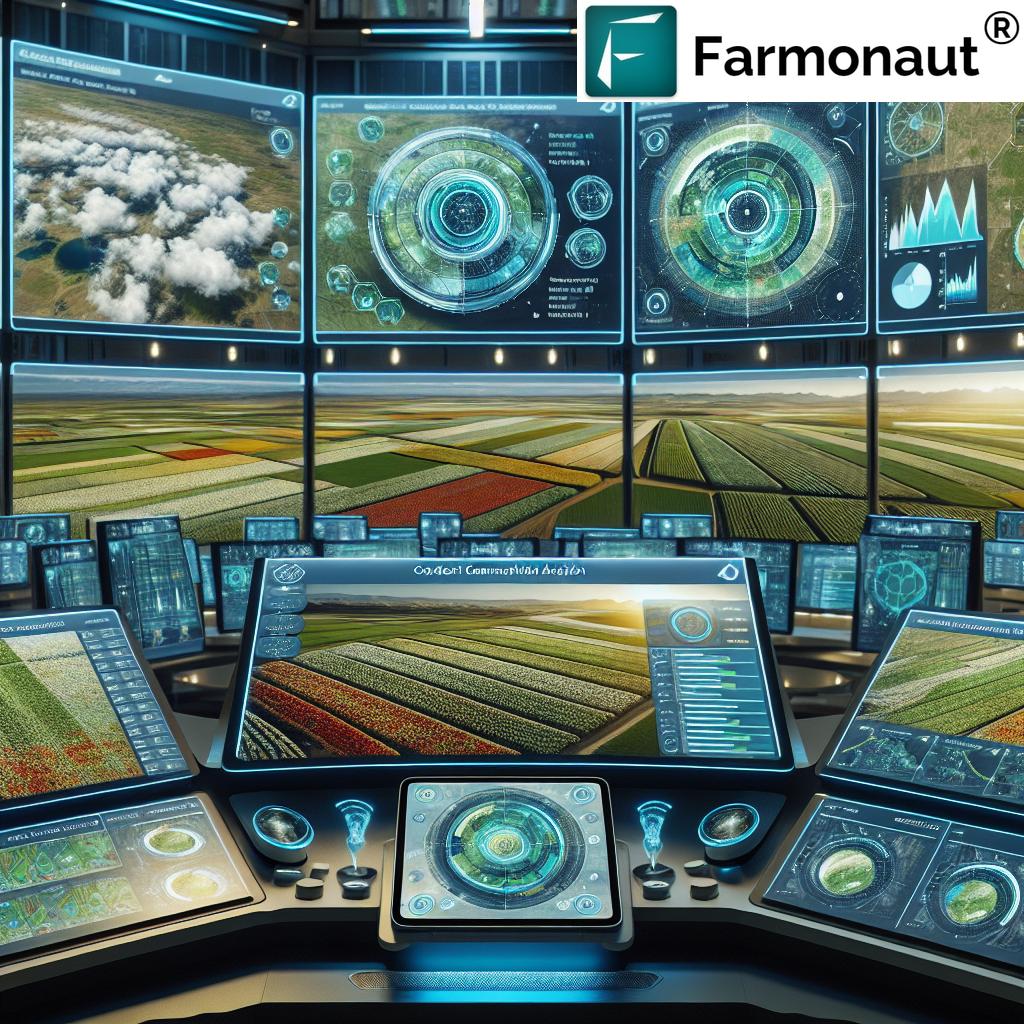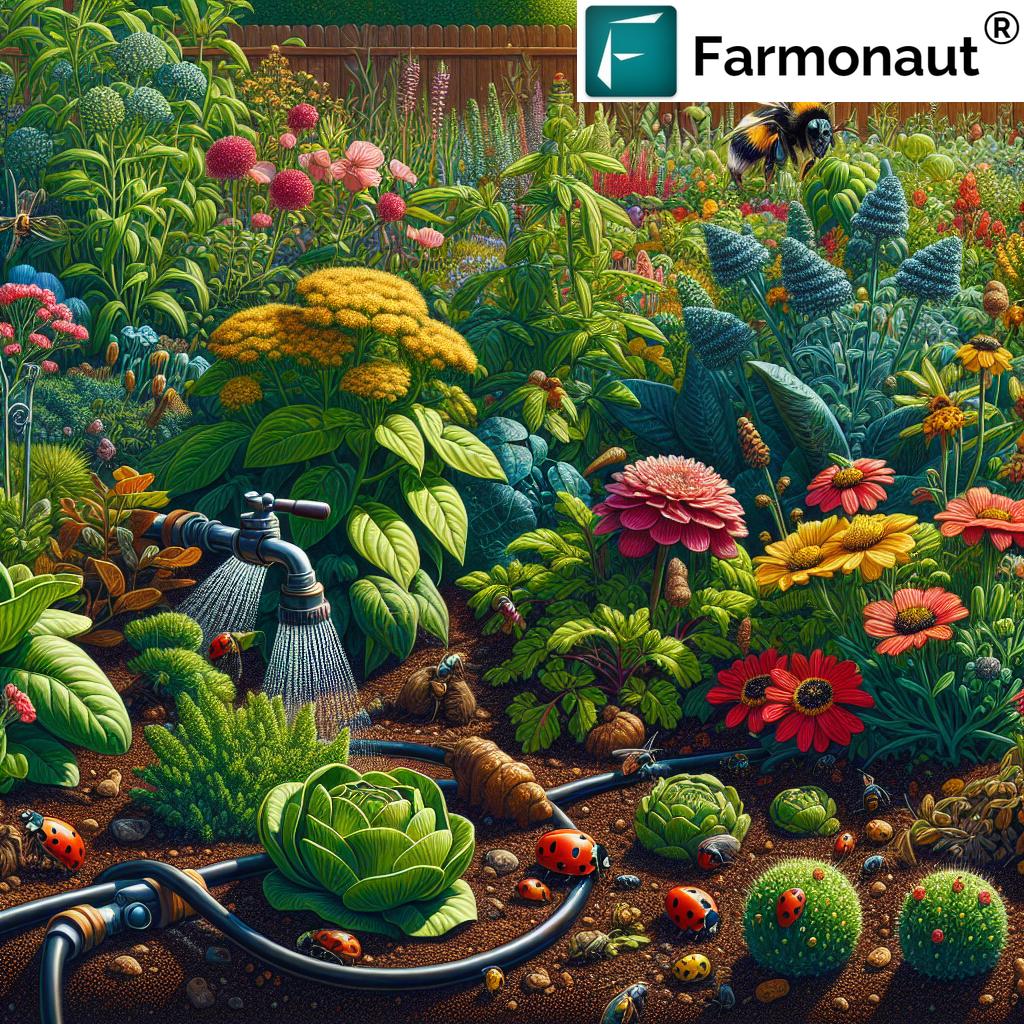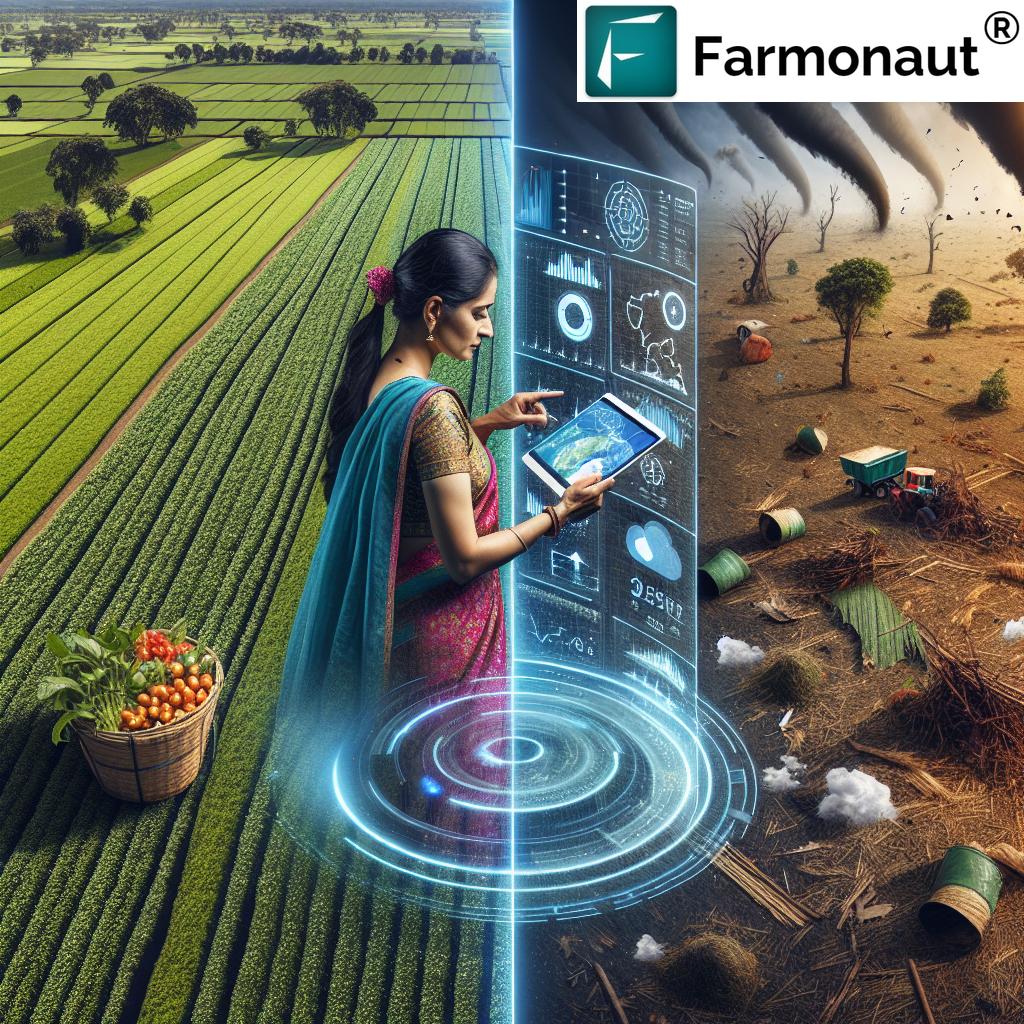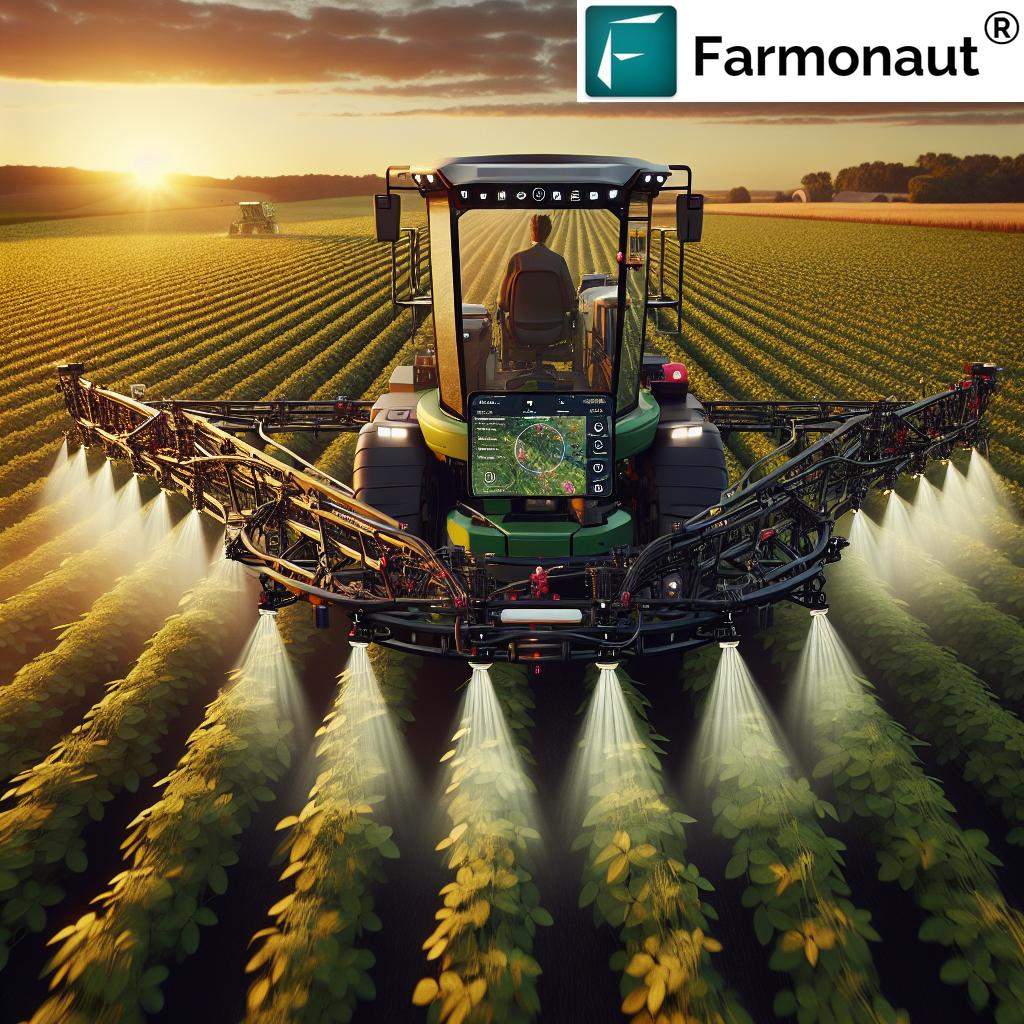Table of Contents
- Introduction: The Path to Sustainable Crop Production
- The 7 Secrets of Sustainable Crop Production
- Soil Health Management
- Water Conservation in Agriculture
- Integrated Pest Management (IPM)
- Agroforestry Benefits
- Conservation Tillage Methods
- Regenerative Agriculture Practices
- Adoption of Innovative Farming Solutions
- Comparative Table: Practices & Impact
- Farmonaut: Empowering Precision and Sustainable Crop Production
- Challenges and Practical Solutions in Sustainable Agriculture
- Frequently Asked Questions
- Conclusion
“Sustainable farming can increase crop yields by up to 79% while reducing water usage by 30%.”
Sustainable Crop Production: 7 Secrets for Massive Yields
As we move further into the twenty-first century, meeting the sustainable crop production needs of a growing global population has become one of the most urgent priorities in modern agriculture. The challenge is not just about maximizing yields; it’s about balancing current food demands with preserving our environment and resources for generations to come. Our approach to agriculture must evolve, embracing practices that are productive, environmentally sound, and socially equitable.
In this comprehensive guide, we will explore the 7 secrets of sustainable crop production that are changing the landscape of food production around the world. We’ll discuss essential themes such as soil health management, water conservation in agriculture, and how innovative farming solutions are empowering farmers to achieve massive, resilient yields—even as they respect the ecological balance that sustains us all.
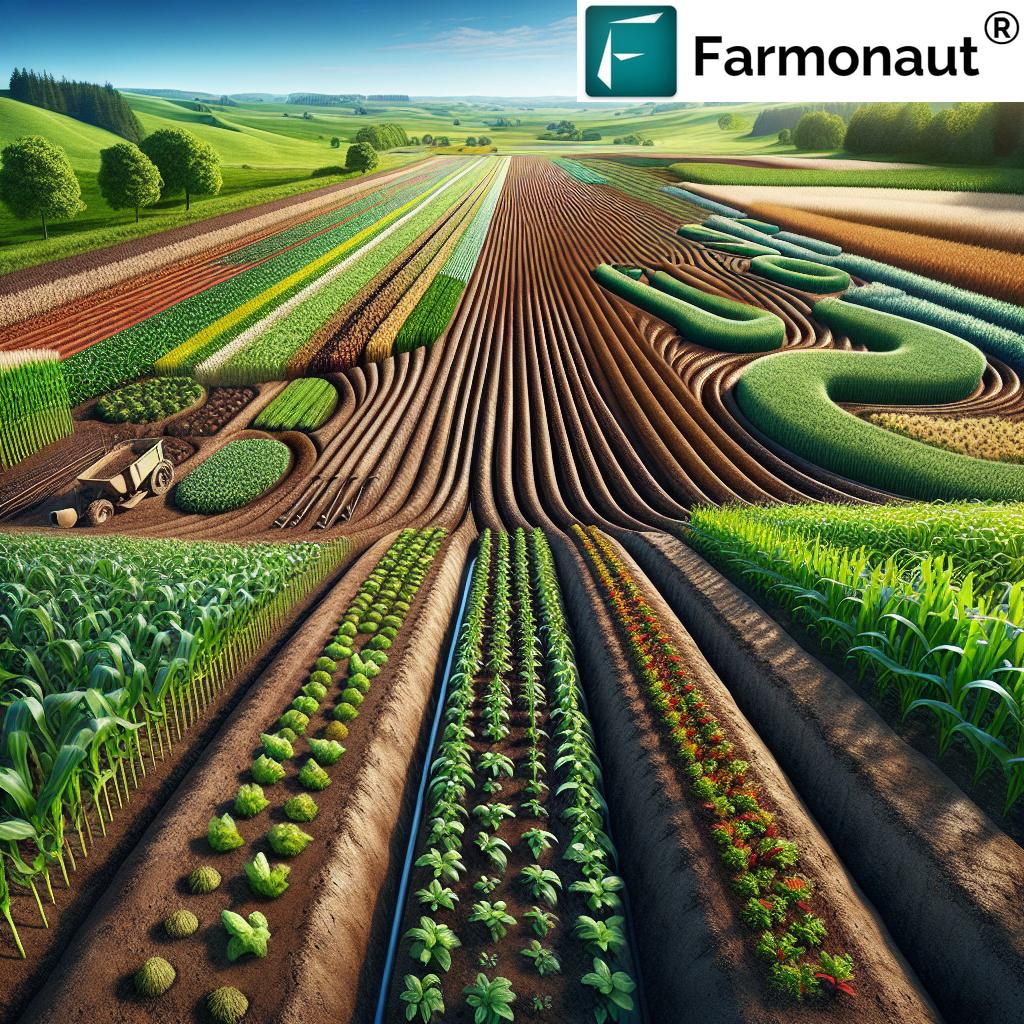
Sustainable crop production is far more than a trend; it is a method and philosophy that emphasizes ecological balance, economic viability, and social responsibility. By integrating time-tested traditions with cutting-edge technologies, we can help farmers and agribusinesses thrive while preserving resources and ensuring food security.
Join us as we uncover each secret, supported by rich examples, research, and practical insights. Together, let’s empower a future where agriculture is truly sustainable, innovative, and bountiful.
The 7 Secrets of Sustainable Crop Production
1. Soil Health Management: The Cornerstone of Sustainable Yields
Soil health management is the starting point for any truly sustainable crop production system. Healthy soil is teeming with organic matter, beneficial microbes, and a well-structured composition that promotes crop resilience and optimizes nutrient uptake. Here’s how we can enhance and maintain soil vitality:
- Crop rotation: Alternating different crop varieties within a field each season can disrupt pest life cycles, balance nutrient levels, and prevent the buildup of soilborne diseases.
- Cover cropping: Planting cover crops, such as legumes or clover, during the off-season helps fix atmospheric nitrogen, enriching the soil naturally while reducing dependence on chemical fertilizers.
- Reducing tillage: Limiting disturbance preserves soil structure, reduces erosion, and nurtures the delicate network of microbial activity essential for nutrient cycling.
- Increasing organic matter: Applying compost, manure, or green manure increases soil’s fertility and buffering capacity against climate stress.
- Managing pH and nutrients: Regular soil tests and careful use of lime or amendments maintain optimal growing conditions for crops.
By adopting these practices, we foster ecological balance, boost productivity, and increase crop resilience to climate change.
Did you know? Healthy soil management practices can improve water retention by over 25%, supporting plants in drought-prone regions and minimizing runoff.
What makes soil health crucial?
Well-managed soil is the foundation for biological nitrogen fixation, robust root systems, and long-term productivity. It acts as both a buffer and reservoir in agricultural systems—increasing fertility, supporting beneficial microbial life, and helping retain moisture.
2. Water Conservation in Agriculture: Efficient Use and Management
Water conservation in agriculture is imperative, especially as climate change brings more frequent droughts and water scarcity to key food-producing regions. Efficient water use not only safeguards against shortages but also enhances soil health and crop yields. Here’s how we can achieve it:
- Drip irrigation: This innovative practice delivers water directly to plant roots, minimizing evaporation and reducing runoff. It’s particularly effective in regions where water is a precious resource.
- Rainwater harvesting: Collecting and storing rainwater for irrigation provides a sustainable alternative to groundwater extraction and reduces costs.
- Mulching: Applying organic or synthetic mulch helps retain soil moisture, reduces evaporation, and improves plant health by keeping roots cool.
- Scheduling irrigation: Using real-time soil moisture data (such as provided by Farmonaut) enables us to water crops only when and where it’s truly necessary, further conserving resources.
- Choosing drought-resistant crops: Opting for varieties with lower water requirements ensures productivity even during dry spells, promoting resilience.
Water is life, and sound management of this resource is key to sustainable crop production.
Helpful resource: Farmonaut’s Satellite API provides actionable insights on soil moisture and irrigation scheduling.
3. Integrated Pest Management (IPM): Balancing Productivity and Ecology
Integrated pest management (IPM) employs a diverse toolbox to manage pests and diseases in an economically and ecologically sound manner. Rather than relying solely on chemicals, IPM combines:
- Biological controls: Introducing or encouraging beneficial insects and natural predators (such as ladybugs or parasitic wasps).
- Cultural practices: Crop rotation, intercropping, and sanitation reduce pest habitat and disrupt pest cycles.
- Physical methods: Barriers, pheromone traps, or manual removal target pests directly while limiting environmental impact.
- Chemical interventions: Only as a last resort, carefully selected and timed to protect pollinators and natural enemies.
IPM reduces input costs, promotes agricultural biodiversity, and keeps ecosystems in balance while maintaining productivity.
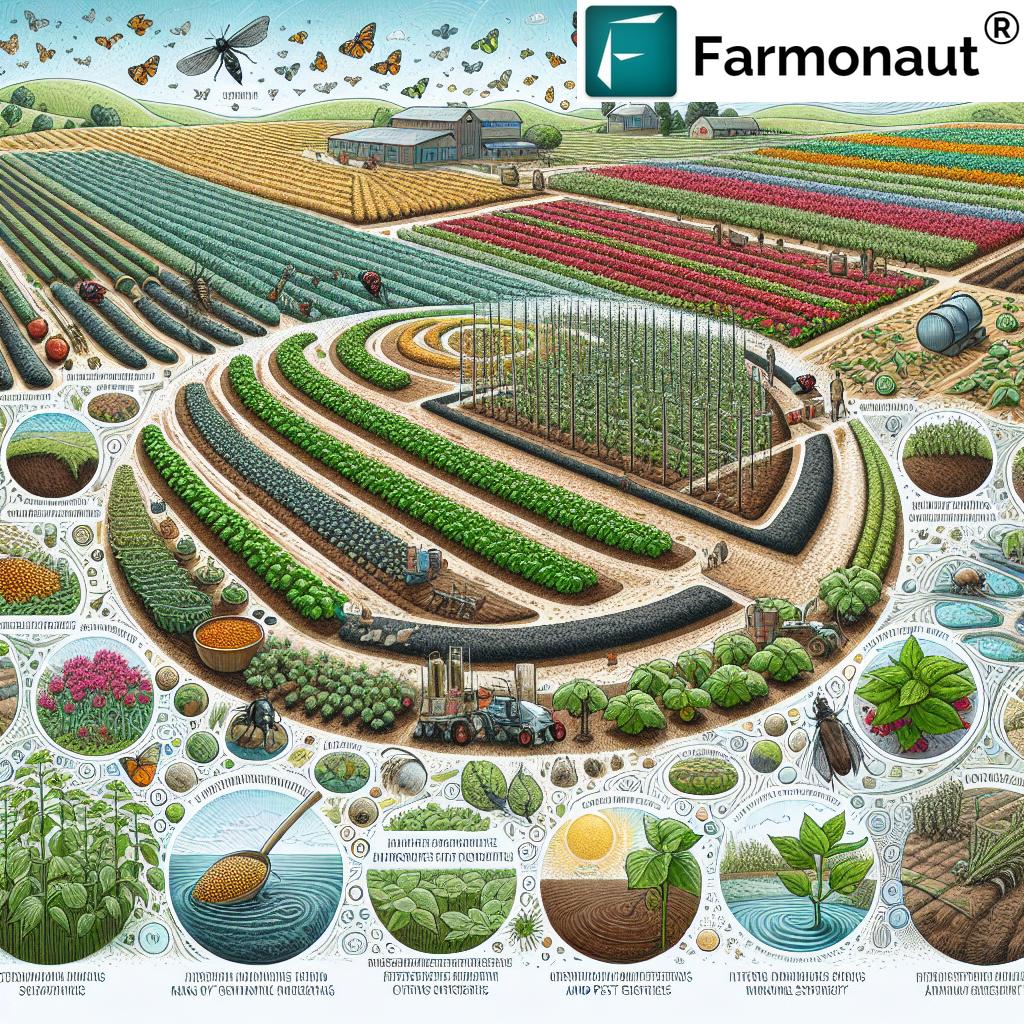
4. Agroforestry Benefits: Integrating Trees for Biodiversity and Profit
Agroforestry is the strategic integration of trees and shrubs into farming systems. This practice offers a wide range of advantages that support both environmental and economic goals:
- Improved biodiversity: Diverse plant species create habitats, attract pollinators, and encourage natural pest predators.
- Enhanced soil fertility: Tree leaves and roots add organic matter and nutrients, boosting soil health.
- Carbon sequestration: Trees store carbon, mitigate greenhouse gas emissions, and help us combat climate change.
- New income streams: Sale of timber, fruit, nuts, or medicinal products supplements farm revenue.
- Erosion control: Tree roots stabilize soil and reduce wind or water erosion risks.
By embracing agroforestry benefits, we strengthen the resilience and economic foundation of our agricultural systems while actively promoting environmental stewardship.
5. Conservation Tillage Methods: Reducing Erosion & Preserving Soil Structure
Conservation tillage methods involve reducing or eliminating plowing to protect the delicate soil structure and minimize erosion. No-till and minimum-till systems enable us to plant seeds directly into undisturbed soil. The benefits include:
- Reduced erosion: Stubble and residue left on the surface buffer wind and water forces.
- Enhanced water retention: Improving infiltration and minimizing runoff in rainy or irrigated regions.
- Improved soil health: Protecting biological life, boosting organic matter, and building fertility over time.
- Lower input costs: Reducing the need for tillage equipment and fuel, and extending equipment lifespan.
Example: A farmer practicing no-till may notice better yields in drought years, thanks to enhanced rainfall absorption and less soil compaction.
“Healthy soil management practices can boost crop resilience to climate stress by over 50%.”
Conservation tillage and sustainable ecosystems
By reducing tillage, we not only preserve soil structure and enhance fertility but also help sequester carbon, contributing to climate mitigation and sustainable agriculture.
6. Regenerative Agriculture Practices: Restoring Soil & Promoting Biodiversity
Regenerative agriculture practices go a step beyond sustainability, focusing on actively restoring soil health and promoting agricultural biodiversity. This holistic approach includes:
- Minimal tillage: Preserves soil structure and minimizes disruption to microbial life.
- Diverse crop rotation: Introducing a greater variety of crops reduces pest and disease cycles and strengthens ecosystem resilience.
- Organic amendments: Compost, biochar, and green manure return essential nutrients and build up soil carbon stores.
- Integrated livestock: Mob grazing and rotational grazing improve nutrient cycling and soil compaction management.
These regenerative practices have been shown to increase yields, reduce chemical inputs, and dramatically improve soil and water retention. We’re not just sustaining, but actually improving our land’s productivity and resilience in the face of climate change.
7. Adoption of Innovative Farming Solutions: Leveraging Technology for Sustainable Success
The agricultural landscape is rapidly evolving thanks to innovative farming solutions. Modern data-driven technologies are making it easier for us to manage crops efficiently and sustainably:
- Precision agriculture: Utilizing satellite imagery, sensors, and analytics, we can apply water, fertilizers, and pesticides only when and where they’re needed. Farmonaut offers affordable, real-time crop health monitoring and AI-based decision guidance (learn more below!).
- AI-based advisories: Real-time alerts on weather, pest outbreaks, and soil status empower farmers to make smarter decisions, maximizing yields and reducing losses.
- Blockchain-based traceability: Enhancing transparency and trust in the agricultural supply chain—Farmonaut makes product tracing accessible to all stakeholders. Explore traceability use cases at Farmonaut Product Traceability.
- Biological nitrogen fixation: The use of inoculant microbes such as Rhizobium or Azospirillum enables crops like legumes to fix their own nitrogen, reducing reliance on chemical fertilizers and improving yields sustainably.
- Resource management tools: Fleet tracking (Farmonaut Fleet and Resource Management), carbon footprint monitoring (Farmonaut Carbon Footprinting), and crop insurance validation are at the forefront of smart farming innovation.
By embracing and adapting these solutions, we’re helping farmers worldwide optimize resource use, reduce environmental impact, and ensure that sustainable crop production is scalable and profitable.
Comparative Table: Practices & Impact
Farmonaut: Empowering Precision and Sustainable Crop Production
To catalyze the benefits of all the above practices, Farmonaut stands at the forefront of precision agriculture technology. Our platform is designed to make precision farming affordable and accessible to farmers of all scales, worldwide.
What sets Farmonaut apart?
- Satellite-based crop health monitoring: We provide multispectral imagery that allows farmers to track vegetation health, soil moisture, and more—empowering smarter decisions for irrigation, fertilizer use, and pest management, thus minimizing inputs while maximizing yields.
- AI-based advisory systems: Our Jeevn AI delivers real-time, personalized farm advice, including weather forecasts and expert crop recommendations, to foster healthy, resilient farms.
- Blockchain-based traceability: Transparency is assured from crop planting to market delivery, helping increase consumer trust and meet regulatory demands. Visit Farmonaut Traceability Solution for more insights.
- Fleet & resource management: Our platform streamlines logistics and machinery use, reducing operational costs. Learn more at Farmonaut Fleet Management.
- Carbon footprint tracking: Monitor and reduce emissions with real-time carbon data and actionable insights. Check out our Carbon Footprinting for details.
- Crop plantation & forest advisory: For large-scale farm or forest production, access Farmonaut’s integrated management tools at Farmonaut Large Scale Farm Management.
- Crop loan and insurance verification: Reduce the risk and burden of crop loans and insurance claims with remote, satellite-based monitoring. See Farmonaut Crop Loan & Insurance Tools for more information.
Farmonaut products are accessible via:
- Android, iOS, and Web Apps (Try the Farmonaut Platform)
- API access for direct data integration: Farmonaut API (API Developer Docs)
- Flexible subscriptions for individual fields, agribusinesses, and institutions—choose what you need and scale as you grow!
Our mission is to empower all farmers and agribusinesses to adopt sustainable, data-driven farming. By lowering the cost barrier and providing advanced innovative farming solutions, we support massive yields and ecological stewardship for the future of agriculture.
Challenges and Practical Solutions in Sustainable Agriculture
Despite the clear benefits of sustainable crop production, farmers and stakeholders still encounter several roadblocks. Here are the most common challenges—and practical solutions to overcome them.
A. Climate Change: Preparing for Uncertain Weather
Challenge: Climate change increases the frequency of droughts, floods, and unpredictable seasons—posing serious risks to crop yields and food security.
Solutions:
- Adopt climate resilient crops: Choose drought- and flood-resistant varieties, and diversify crop rotations for adaptability.
- Improve water management: Implement irrigation technologies and conservation methods to optimize limited supplies.
- Enhance soil organic matter: Higher organic content increases moisture retention and buffering capacity.
- Utilize real-time monitoring: Platforms like Farmonaut offer weather analytics and soil moisture data for timely interventions.
B. Economic Constraints: Making Sustainable Investments
Challenge: Transitioning from conventional to sustainable practices may require an upfront investment of time, training, and capital—especially difficult for smallholder farmers.
Solutions:
- Flexible technology options: Choose cost-effective solutions like Farmonaut’s satellite-based monitoring that eliminate expensive on-field infrastructure.
- Financial instruments: Access crop loans, insurance, and government support for sustainable transitions. Farmonaut helps streamline verification and reduce fraud risks.
- Start small, scale up: Implement one or two practices at a time, expanding gradually as you realize returns and build resilience.
C. Knowledge Gaps: Bridging the Sustainability Divide
Challenge: Many growers lack reliable access to knowledge about the best practices for soil health, water conservation, or pest management.
Solutions:
- Extension services: Participate in government or non-profit education programs and workshops.
- Leverage digital advisory platforms: Get real-time, personalized help via in-app AI advisors, such as Farmonaut’s Jeevn AI.
- Online communities: Join farmer forums or networks to share successes, questions, and local adaptation tips.
By recognizing these challenges and deploying targeted solutions, we collectively advance towards global food security and climate resilience.
Frequently Asked Questions: Sustainable Crop Production
What is sustainable crop production?
Sustainable crop production is a holistic approach to agriculture that seeks to meet current food demands while preserving the environment and resources for future generations. It focuses on ecological balance, economic viability, and social responsibility by integrating soil health management, water conservation, biodiversity, and climate resilience into farming practices.
How can farmers improve soil health naturally?
Farmers can improve soil health naturally by adopting crop rotation, cover cropping (e.g., planting legumes), reducing tillage, adding compost or manure, practicing agroforestry, and maintaining optimum pH and nutrient balance in their fields.
What are the most effective water conservation techniques in agriculture?
Drip irrigation, rainwater harvesting, mulching, and real-time soil moisture monitoring (such as with Farmonaut’s satellite tools) are among the most effective ways to conserve water and ensure crops receive optimal hydration with minimal waste.
Why is integrated pest management (IPM) better than conventional pesticides?
IPM combines biological, cultural, and physical tools to manage pests with minimal reliance on chemicals. This approach reduces environmental impact, preserves beneficial organisms, and extends the effectiveness of pest control methods by preventing resistance.
How do innovative farming solutions like Farmonaut support sustainable agriculture?
Farmonaut’s solutions use satellite imagery, AI, and blockchain to help farmers monitor crop and soil health, optimize input use, track environmental impact (like carbon footprint), ensure supply chain transparency, and streamline resource/fleet management—all supporting sustainability and productivity.
What is the difference between sustainable and regenerative agriculture?
Sustainable agriculture aims to maintain productivity and conserve resources for the future, while regenerative agriculture goes further by actively restoring and improving soil health, carbon content, and ecosystem function—creating continuously enhancing farm environments.
Can sustainable crop production really increase yields?
Yes! Research shows sustainable practices can increase crop yields by up to 79%, while improving soil resilience and reducing water and chemical input requirements.
Conclusion: Cultivating a Sustainable Future in Crop Production
As global demands rise and climate change threatens traditional farming systems, embracing sustainable crop production is no longer an option—it’s an imperative. Through holistic soil health management, water conservation in agriculture, integrated pest control, and the adoption of innovative solutions like Farmonaut, we can not only meet current food needs, but also actively protect our planet for the next generation.
By supporting farmers with clear recommendations, actionable technology, and an ecosystem built around responsible practices, we are collectively fostering a resilient, equitable, and productive agricultural future.
Let’s join hands to make sustainability, productivity, and technological progress the hallmarks of global agriculture.
Ready to experience more yield with less effort, while preserving our earth? Try Farmonaut on the web, Android, or iOS today and step into the future of farming.










